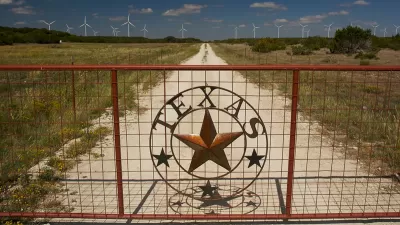The Arctic blast that shut down power to millions of Texas households last week has brought renewed attention to the isolated Texas power grid that prevented the operator from importing out-of-state electricity.

There are three power grids in the lower 48 states: the Eastern Interconnection, the Western Interconnection, and the Texas Interconnection.
Kate Galbraith, the former energy and environment reporter for The Texas Tribune, penned a go-to piece about the uniqueness of Texas having its own power grid that's as relevant today as it was when she wrote it ten years ago after an Arctic blast shut down 152 generating units, 28% of the generators that supplied electricity to the power grid operated by the Electric Reliability Council of Texas (ERCOT).
Asher Price, also an energy and the environment reporter who has been covering Winter Storm 2021 for the Austin American-Statesman, referenced Galbraith in her own piece (source article) published Feb. 16 explaining the roots of what Bill Magness, CEO of ERCOT, the electric grid operator for 90 percent of the Lone Star State, calls "an electrical island in the United States."
The reasons Texas controls its own grid, the journalist Kate Galbraith observed in a Texplainer piece for the Texas Tribune in 2011 have to do with the same theme that colors so much of Texas' history and public policy: a distrust of federal interference.
"Texas' secessionist inclinations have at least one modern outlet: the electric grid," wrote Galbraith on Feb. 8, 2011, six days after "Texas imposed statewide rolling blackouts for only the second time in over two decades."
Before ERCOT
ERCOT's predecessor was the Texas Interconnected System which was formed, in part, to stay out the reach of the Federal Power Commission which was charged with overseeing interstate electricity sales after President Franklin D. Roosevelt signed the Federal Power Act that changed the name of the 1920 Federal Water Power Act.
"The ERCOT grid remains beyond the jurisdiction [pdf] of the Federal Energy Regulatory Commission, which succeeded the Federal Power Commission and regulates interstate electric transmission," adds Galbraith.
Bottom line: Texas has its own grid to avoid dealing with the feds.
Price adds:
"Utilities in Texas were smart and made an agreement that no one was going to extend power outside of Texas," Donna Nelson, who served as chair of the state Public Utility Commission, which oversees ERCOT, from 2008 to 2017, said in an ERCOT promotional video about the history of the grid.
Not extending power outside of Texas also meant that during Winter Storm 2011, ERCOT was not able to import electricity from the Eastern and Western Interconnections, one of the reasons why 4.3 million Texans lost power last week and dozens of people died.
Related in Planetizen:
-
Blaming ERCOT, Feb. 22, 2021
-
California-Style Rolling Blackouts Come to Texas, Feb. 18, 2021
-
Bridging the Divides in the U.S. Electricity Grid, August 9, 2018
FULL STORY: Why is Texas the only state with its own power grid?

Alabama: Trump Terminates Settlements for Black Communities Harmed By Raw Sewage
Trump deemed the landmark civil rights agreement “illegal DEI and environmental justice policy.”

Planetizen Federal Action Tracker
A weekly monitor of how Trump’s orders and actions are impacting planners and planning in America.

Why Should We Subsidize Public Transportation?
Many public transit agencies face financial stress due to rising costs, declining fare revenue, and declining subsidies. Transit advocates must provide a strong business case for increasing public transit funding.

Understanding Road Diets
An explainer from Momentum highlights the advantages of reducing vehicle lanes in favor of more bike, transit, and pedestrian infrastructure.

New California Law Regulates Warehouse Pollution
A new law tightens building and emissions regulations for large distribution warehouses to mitigate air pollution and traffic in surrounding communities.

Phoenix Announces Opening Date for Light Rail Extension
The South Central extension will connect South Phoenix to downtown and other major hubs starting on June 7.
Urban Design for Planners 1: Software Tools
This six-course series explores essential urban design concepts using open source software and equips planners with the tools they need to participate fully in the urban design process.
Planning for Universal Design
Learn the tools for implementing Universal Design in planning regulations.
Caltrans
Smith Gee Studio
Institute for Housing and Urban Development Studies (IHS)
City of Grandview
Harvard GSD Executive Education
Toledo-Lucas County Plan Commissions
Salt Lake City
NYU Wagner Graduate School of Public Service





























